Exponent II's Blog, page 16
July 24, 2025
Violent Patriarchy and Polygamy of Some Mormon Pioneers
Today, the LDS Church celebrates the arrival of the Mormon pioneers in the Salt Lake Valley. Lavish parades and fireworks will recognize their contribution to settling the American West and in building cities and towns in desert valleys. The pioneers’ sacrifices and hard work deserve to be celebrated. Many left the comforts of home and trekked to an unfamiliar land with harsh conditions. Some starved while others endured unspeakable sorrow as they buried children and faced brutal weather conditions while building makeshift homes. For all who sacrificed mightily for their religious beliefs with the desire to worship freely, I say, “thank you.”
Although the Church venerates the Mormon pioneers and their leader, Brigham Young, some significant facts are overlooked. The LDS Church ignores the fact that Mormons settled land that was home to many Native American tribes, including the Shoshone, Paiute, Ute, Goshute, and Navajo. Pioneers took from these people prime fishing and hunting properties and usurped resources that Native Americans had used for thousands of years. The Church also disregards the suffering of the Mormon pioneer women who were coerced into polygamous relationships, often at the expense of their children and families.
Problems with Violent Pioneer Patriarchy
An LDS manual states that “some Indians were living in the area when the Saints arrived. Sometimes there were problems between the Saints and the Indians. Brigham Young told the Saints to be kind. Many of the Indians became their friends, and some became members of the Church.” Nothing is mentioned that Mormon settlers dispossessed Native Americans of their homes, their land, and their means of feeding their families.
What LDS history manuals omit is the sometimes violent treatment by the LDS patriarchy of Native Americans in Utah. In 1850, Brigham Young ordered the Mormon militia to attack and destroy the Timpanogos tribe in Utah County after a disagreement that started when settlers accused a Timpanogos neighbor of stealing a shirt. Pioneers killed the alleged thief and later informed Young that the Timpanogos were taking their corn and cattle in retribution for the killing.
Young then ordered the massacre of the tribe, saying that the militia should “not leave the [Utah Valley] until every Indian was out, according to his general. Between forty and one hundred Timpanogos men were slaughtered, and 40-50 skulls were displayed in Fort Utah, which later became Provo. Many Timpanogos widows and orphans were placed as servants in LDS homes, where some died and others escaped.
In 1852, Young legalized Native American slavery in Utah. Within a decade, at least 400 Native American children served as slaves in Mormon households, and within 50 years, the Native American population in Utah declined by 86 percent.
The LDS Church cannot claim to be “true” until it acknowledges and apologizes to the Timpanogos people for this atrocity, along with other atrocities that are not recorded. Until it does, it will continue to repeat a pattern of imperialism and subjugation of minority groups.
Although most Mormon pioneers were peace-loving people, some followed the orders of their ecclesiastical leaders and participated in brutal and unspeakably violent attacks on Native Americans, who deserve an apology for the abuse, death, and displacement that their forebears suffered at the hands of LDS people.
Darren Parry, LDS Shoshone scholar, writes, “We did not invite the Mormon pioneers to this valley, but they came nonetheless… with little thought given to who they might hurt or displace.”
Problems with Pioneer Polygamy
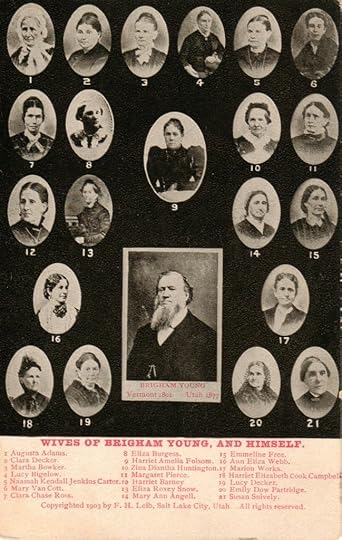
In addition to the horrors of genocide, the pioneers’ practice of polygamy also brought suffering to many. Excellent writers have written posts in the Exponent II blog about the abuse many women and children experienced in polygamy, including Abby Maxwell Hansen, Candice Wendt, and Linda Hamilton.
Linda writes:
“[D&C 132 says that] women who refuse to give consent to polygamy will be destroyed. How can women be true agents when they are told they must consent or face destruction? Women are something to be collected, told what to do, and obey. They are given in marriage and received like a present or a prize.
“In the doctrine of plural marriage, men are required to be married to receive exaltation and achieve godhood. As Brigham Young taught: The o’nly men who become Gods, even the Sons of God, are those who enter into polygamy.”’A woman—a plural wife—is a literal ticket to heaven for men.
“Or to put as plainly as Heber C. Kimball: ‘I think no more of taking a wife than I do of buying a cow.’”
Some say that Mormon pioneers needed to practice polygamy because women vastly outnumbered men, yet BYU and LDS researchers found that “the gender breakdown of the Mormon immigrants is balanced, with 26,615 females and 28,306 males. A Church apologetic site, Fair Mormon, agrees, stating that “the United States census records from 1850 to 1940, and all available Church records, uniformly show a preponderance of males in Utah, and in the Church as a whole.”
With more pioneer males than females, some males were denied marital opportunities when LDS leaders married many girls and women in polygamous unions. In addition, many polygamous women were left alone to support themselves and their children while their husbands served in demanding church callings or left for foreign missions.
Fourteen of my direct ancestors were Mormon polygamous pioneers, and these women and their children often suffered terribly as their husbands lacked the time and resources to care for their huge families. The agony, aloneness, and anguish of polygamy are steeped in my DNA. The intergenerational trauma of food insecurity, child neglect, and desperation for shelter and necessities prevailed in polygamous households where men seldom saw their families, left their wives and children for prolonged periods as they served missions and fulfilled church assignments, and where obedience trumped love.
Polygamy is still steeped in the LDS Church, with the current top two leaders married and sealed for eternity to two women, and where posthumous polygamous marriages are routinely performed in LDS temple ceremonies. Polygamy often involved sexual trafficking and has influenced the current LDS culture, where women are too often abused, marginalized, and dehumanized, and where child sexual abuse is frequently ignored.
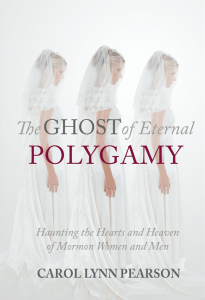
Carol Lynn Pearson, an acclaimed LDS writer and scholar, created an online survey regarding LDS eternal polygamy policies, and over eight thousand people responded. Some said:
“I live in constant fear that I will die before my husband and he will be sealed to a second wife, meaning I will live in a polygamous relationship for eternity. I’ve told him if this happens I will choose hell over heaven and he believes me. This is hard on our marriage.”
“A nice Mormon guy hung up the phone when he found I was a sealed widow. He said, ‘Why would I want to love someone in this life and then turn her over to her first husband for eternity?—along with the children that came from my very own DNA and now belong to him?’”
“When I was a teenaged boy, I thought it was cool to look forward to lots of sex with my circle of wives in heaven. Now the idea of eternal polygamy disgusts me. No way do I want my wife to feel like I have all of her and she doesn’t have all of me. Crazy stuff, this doctrine.”
In her powerful book, Ghost of Eternal Polygamy, Ms. Pearson writes, “The electrifying, secret whispers of the Prophet Joseph and the loud sermons of Brigham Young still echo through chapels, temples, homes, and hearts, assuring the Saints that we are not yet finished with polygamy.”
She adds that this doctrine causes large numbers of women to fear heaven, to question their worth, and to leave the church.
Becoming Modern-day Pioneers
To all Mormon pioneers, I say, “thank you for your sacrifices,” and “I am sorry for the needless suffering you may have endured in polygamous unions. Whatever the afterlife is or is not, I hope you find peace as some of your descendants speak out against flaws and abuses of harsh patriarchal systems.”
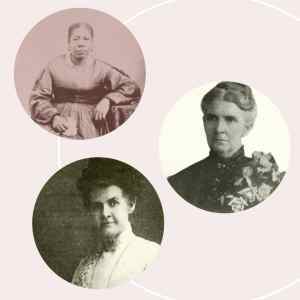
I honor Ellis Shipp, one of the first women doctors in Utah, Jane Manning James, one of the first Black settlers in the Salt Lake valley, and Martha Hughes Cannon, a physician and suffrage leader who ran against her husband, an LDS stake president, for Utah state senate and won; Martha was the first female state senator in the nation.
I honor all modern-day pioneers who, against all odds, befriend the outsider, feed the hungry, and show kindness when others are indifferent. I celebrate all those who seek to do what is right, even when painful consequences follow. I honor modern LDS pioneers who have pleaded for the right to worship Heavenly Mother, to attend male-centric meetings, and to protect LDS children, and who have been severely punished for doing so.
Female pioneers forged the way for women to vote, own property, and receive equal pay for equal work. Perhaps some day they will inspire patriarchal leaders to treat women with equity, respect, and justice in churches and cultures that marginalize and exclude them. Someone once wrote, “It takes bravery to leave what is known and venture into the unknown, to forge a path where none exists.”
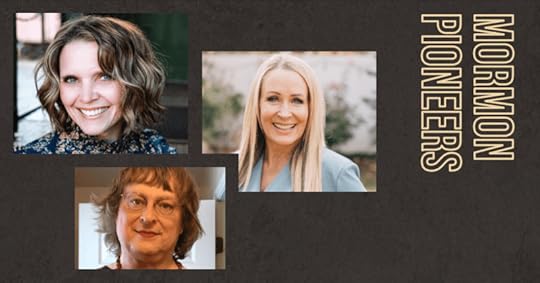
May each of us be brave Mormon pioneers like Laurie Lee Hall, Julie Hanks, Valerie Hamaker, and many others, as we seek to follow the dictates of our consciences and be true to the best that is within us.
July 23, 2025
Guest Post: They Told Me I’m a Kite
Guest Post by Amber Ethington
 Photo by Shreeya Pradhananga on Unsplash
Photo by Shreeya Pradhananga on UnsplashAs a girl I was taught a story about a boy who flew a kite with his dad. They let the kite go and it soared up into the air. The boy gradually let the string out and the kite went higher and higher until the string was tight. The little boy was thrilled. Look how high the kite was! He said to his dad, “I want the kite to go higher! Cut the string so it will go higher!” The dad said no, if he did that the kite would fall. But the boy insisted and the dad cut the string. The kite fell to the ground.
I was taught that I am a kite. I need a string to fly. I need to stay grounded to the rules and traditions of my fathers. I need a man to hold the string.
I was an ambitious kite and I was good at flying. I flew as high as that string would allow and I enjoyed the beautiful view from those heights. For a long time I soared.
Then, one morning, I wasn’t flying as high. Someone had pulled the string and brought me a little closer to earth. I couldn’t quite reach the sky anymore. They told me the sky was dangerous. They pulled the string tighter and gradually, my view narrowed. But that was ok; I needed to stay tied to earth to weather the storms! After all, they could see things that I could not. They had to pull me down so I would be safe. They just wanted me safe.
Eventually I couldn’t see a view anymore. Just the ground growing closer and closer and the sky falling away above me.
Sometimes I would meet other kites. These kites had no strings. “Of course,” I thought, “it is just a matter of time before they fall. Kites need tight strings to fly.” But these kites didn’t fall. They told me that the views up there were terrifying, but also glorious. They told me I was meant to reach the stars.
I had been warned about these kites. Eventually these untethered kites would fall and they wanted me to crash to the ground with them! I believed this as hard as I could while I slowly saw the ground coming closer to me. I could barely lift my kite self above the trees anymore.
So I cut that string. And I floated into the air.
Turns out, I was a balloon all along.

Amber is a (mostly) stay-at-home mom and a voice teacher. She loves to sing, perform on stage, learn new skills, and read lots of books. She thinks libraries and mountains are sacred places: temples, if you will. She thinks personality tests are fun (ENFP and Enneagram 4!) and she enjoys reading tarot for herself and others. She left the church in 2022 and is now navigating life in a happy mixed-faith marriage.

Guest Post: Due Process…Denied
Guest Post by Jodi
 Photo by Tingey Injury Law Firm on Unsplash
Photo by Tingey Injury Law Firm on UnsplashYears ago, I worked for a large company where I was part of a union. I never thought I’d need that union—until the day I did. After five years of loyal service, I was called into a meeting with my supervisor. I was told there would be others present, but not who they were. I wasn’t concerned—I hadn’t done anything wrong.
When I arrived, I was introduced to two people from headquarters and a union representative “for me”—a friend, though we’d never discussed anything related to this meeting. From the moment it began, it was clear something was off. I was bombarded with questions about my personal life, distant work history, and irrelevant details I couldn’t possibly remember. Any hesitation on my part was met with eye rolls and judgment—not just from management, but also from my supposed advocate. I was blindsided with accusations of unethical behavior, with no prior warning, and the decision had clearly already been made. A different supervisor—one I had never worked with—offered me two options: resign or be fired. Cornered and forced to make an instant decision, I chose to resign. I left with confusion and shame—but not guilt, because I knew I had done nothing wrong.
Months later, I ran into that second supervisor. He had since been fired and shared what really happened: the agency was overstaffed, and leadership needed to downsize. I had been chosen as collateral damage. Nothing I could’ve said or done in that meeting would’ve mattered. He had been a pawn, too—forced to deliver the blow or face termination himself, which eventually came anyway.
I often think of that experience when I hear about church disciplinary councils. I’ve never been through one personally, but I’ve watched many friends and family members suffer through them—shamed, excluded, and ultimately silenced. In the words of one friend whose husband was excommunicated, “It was awful. The entire process is f@cked up and there is no Jesus in it, but I hope it will bring him back to the church somehow.” Should a church that claims to be Christ’s church be treating its members this way?
In these councils, there is no true advocate for the accused. Maybe a letter of support is allowed. Maybe a friend can attend—though often not even that. If excommunication is the outcome, there’s no true appeal process, no defense, no space for nuance. Much like my own experience, the decision is often made before the meeting begins.
Imagine a court of law where the prosecutor, defense attorney, jury foreman, and judge were all the same person. That’s effectively how church discipline functions: the stake president investigates, prosecutes, claims to defend, influences the vote, and delivers the final verdict. Ultimately he represents the church—its reputation, its image, its agenda—not the individual. The illusion of fairness hides a system built to protect the institution, not the person.
In my friend’s case, her hope that excommunication will spark change is rooted in fear and conditioning. Sure, spanking may stop a toddler’s behavior—but what does it teach? That love is conditional? That power wins?
Disciplinary councils are not redemptive. They are controlling and coercive. Just like the meeting that ended my job, they strip people of dignity under the pretense of due process. I look forward to the day this practice is abolished. Until then, I hope more members put in this situation can find the courage to simply say “No”—to refuse to take part in something so clearly unjust, unkind, and un-Christlike.

Jodi is a mom of 6, Gigi of 3 1/2, and lifelong truth-seeker who values compassion, joy, and standing up for what’s right—even when it’s hard
July 22, 2025
Don’t Miss Exponent II Sessions at Sunstone Next Week!
Exponent II is hosting and participating in exciting sessions at this year’s Sunstone Symposium. All Exponent II related sessions are on Saturday, August 2
Learn more about Sunstone (July 31–August 2 in Salt Lake City, Utah) and register to attend here.
Author Meets Critic: 50 years of Exponent II
Saturday, August 2
9:00 am – 10:00 am
Authors Katie Ludlow Rich and Heather Sundahl will discuss their book “Fifty Years of Exponent II” (Signature Books, 2024) with a panel of critics. “Fifty Years of Exponent II” chronicles the evolution of a groundbreaking Mormon feminist publication that has created space for women’s voices, questions, and community across generations. This history reveals how women and gender minorities—often on the margins—shaped conversations around gender, faith, and power within and beyond the LDS Church. Joining the authors will be discussion moderator Millie Tullis (she/they), the new editor-in-chief of Exponent II magazine; Maxine Hanks, author of “Women and Authority: Re-emerging Mormon Feminism”; Susan Hinckley and Cynthia Winward, hosts of the “At Last She Said It” podcast; and Blaire Ostler, author of “Queer Mormon Theology.”
Speakers:
· Katie Ludlow Rich (she/her)
· Heather Sundahl
· Maxine Hanks
· Susan Hinckley
· Cynthia Winward
· Blaire Ostler
· Millie Tullis (she/they)
Writers of Witness: A Reading from the Exponent II Community
Saturday, August 2
10:25 am – 11:55 am
Exponent II provides feminist forums for women and gender minorities across the Mormon spectrum to share their art and stories and foster community and acceptance. This session will feature a variety of readings published by the Exponent II magazine and blog, highlighting some of the best in contemporary writing by women and gender minorities across the Mormon spectrum. Readers include poets, essayists, and bloggers. Millie Tullis will emcee, introducing each reader and managing the time. Each reader will read for 5-7 minutes, and there will be a short window of time for questions/comments at the end.
· Cynthia W. Connell (she/her)
· R.A. Davis
· Jody England Hansen (she/her)
· Abby Maxwell Hansen (she/her)
· Melody Newey Johnson
· Melissa Malcolm King
· Alma Frances Pellett
· Elizabeth Pinborough (she/her)
· Natasha Rogers (she/her)
· Melissa Tyler (she/her)
· Millie Tullis (she/they)
“as if / one pair of eyes were a whole hive”: Writing the Personal, Writing in Community (a Generative Poetry and Essay Writing Workshop)
Saturday, August 2
5:55 pm – 6:55 pm
Workshop with Millie Tullis, Exponent II, incoming Editor-in-Chief
In May Swenson’s poem, “The Truth Is Forced,” she states, “One must be honest somewhere. I wish / to be honest in poetry.” Swenson compares truth-telling to “taking off my clothes,” and describes how “your eyes would swarm me… cloying, itching, greedy bees.” To Swenson, telling the truth is bold and exposing. She confesses, “Really, I feel as if / one pair of eyes were a whole hive.” This generative creative-writing workshop will begin with a close reading of May Swenson’s “The Truth Is Forced;” participants will briefly discuss the challenges and opportunities that arise from telling the truth about ourselves and our communities in our writing. Participants will be provided with a variety of poetry and personal essay prompts touching on personal experiences within Mormonism, family, culture, and memory. Workshop participants will then write in community for 30-45 minutes. Workshop participants will have the opportunity to briefly share, discuss, and respond to each other’s new work at the close of the workshop. Participants do not need to have any previous creative writing experience. All writing levels and identities are welcome to join.
Photo by Anna Ream Photography, taken in 2024 at the “Fifty Years of Exponent II” launch party in Massachusetts.
Our Bloggers Recommend: The Great Feminist Exhaustion
Are you an exhausted feminist?
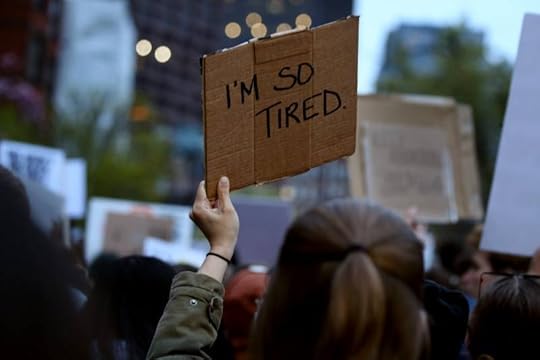
…”I’m also talking about the women who grew up in high-control religions, understanding feminism as a core evil, who have come to embrace it but still struggle with deeply internalized misogyny. I’m talking about people who always felt like feminist spaces were too white, or too middle-class, or too obsessed with respectability — but got shunned if they voiced as much. I’m talking about everyone who thought that the best way to live their feminist values was to do it all — marriage, kids, career, house — and everyone who thought the best way was to reject doing it all, but are now exhausted by navigating precarity that’s only exacerbated by how much our country privileges partnered home-owners. I’m talking about people who’ve been at the center of this work for decades and people alienated by feminists in the 2014 Jezebel comments. We are exhausted….”
Link to ArticleThe Critics of Dr. Julie Hanks
There has been quite a bit of chatter regarding Dr. Julie Hanks and her decision to step away from the church. More specifically, some members of the church have shared their disliking toward her work and have even criticized her personally.
I’ve pulled a few snippets from the comment sections found on the Exponent II blog and from our social media pages. There are consistent themes among the critics that I think are worth examining. Let’s take a look at some examples. I will leave the names of the commenters anonymous.
“I find it VERY sad that Dr. Julie Hanks and others have chosen to naysay instead of pray.”
“Julie Hanks has been a wolf in sheep’s clothing for sometime with the church.”
“She rebelled against church leaders, their doctrine, and their policies. She vocally and publicly denounced church leaders and church doctrine. Because of her rebellion against the church and its leaders, she led MANY members right out the door. And now, she’s led herself out. This is precisely what apostasy looks like. And now, she’s not only lost her membership in God’s kingdom, but her husband, too. Very sad for her. But she brought it on herself.”
“Julie Hanks clearly did not subscribe to the doctrines of the church, and therefore, God. She pushed for things that will never be changed within the church. When you do that in the LDS church, you are apostate. You are a wolf. You become an anti Christ.”
“She preached false doctrine while pretending to be an active member of the church. She willing and intentionally preached against the church and it’s leadership. I listened to her enough to know. I saw the effect her teaching has had on others, too, as she led others away. She was not excommunicated, she pridefully chose to leave the church. Why should she, or anyone who actively works against the church, expect to remain unchallenged and uncorrected? If she doesn’t believe the teachings, why stay a member? At least now she can’t hide behind the pretense of being a member in good standing. Hopefully, she’ll be less able to be a spiritual ‘wolf in sheep’s clothing’ any longer. Those who might have trusted her will now know she’s an apostate and can choose whether to receive therapy from her or not, fully informed, and therefore less likely to be deceived.”
I’ll be the first to say that all of these commenters are entitled to their opinions. I will also say that after seeing these comments, I felt sick to my stomach. I feel awful for Julie Hanks and the hate she has had to endure. One has to wonder where the Christlike love has gone.
Let’s break down four of the consistent themes found within these comments.
1) Attacks on Personal Character
Calling her a “wolf in sheep’s clothing” seems to be a common belittling tactic, and happens to be one that holds no merit.
When an institution or a culture argues that a professional therapist, who is speaking from a professional standpoint, is a wolf devouring innocent prey, we have a big problem on our hands. Rejecting best mental health practices in defense of your religion’s status quo is not the flex you think it is. Any institution that opposes best mental health practices is hoisting a very large red flag.
Further critiques include calling her a “naysayer,” an “apostate,” and an “anti-Christ.” She was accused of being prideful and rebellious. All from people who have never met her. People who don’t know her personally. This screams unrighteous judgement. And it’s just a tad bit presumptuous, to say the least. Which leads us to our next category.
2) Assumptions, Assumptions, and More Assumptions.
Why is it assumed that Julie Hanks does not pray? Do you have a bird’s eye view into the privacy of her bedroom? Do you know her very personal and private spiritual experiences? I’ll answer that one for you: No. You don’t.
Why connect her decision to leave the church to her divorce? Do you know her and her husband? Do you know the intimate details behind their marriage? Do you even know why they had a divorce? I’ll answer that again: No. You don’t. How very cruel to bring up a very personal experience in her life and liken it to her leaving the church.
She clearly did not subscribe to the doctrines of the church, and therefore, God?
She pretended to be an active member? She doesn’t believe the teachings?
How do you know any of this when you do not know her personally?
The reality is, you don’t know any of this. You are making assumptions based off the very limited understanding that you have about Julie Hanks and her personal life.
Just because she disagrees with some of your beliefs does not mean that you can assume any of the above. It does not give you the leeway to casually toss out whatever claims you want because you happen to not like her views. Assumptions are dangerous, slanderous, and more often than not, they are wrong.
3) False Accusations
Some have claimed that Julie Hanks encouraged others to leave the church along side her. Others have said that she lead many others out of the church, suggesting that she was intentionally deceitful by appearing to be an active member when she actually wasn’t.
All of these are false accusations that are simply untrue.
She has never encouraged others to follow her out of the church. She also doesn’t tell people to leave the church in her private practice. She encourages people to do what is best for them, because that just so happens to be good therapy. Encouraging someone to either stay or leave the church would be inappropriate.
She has been very upfront about her social media presence NOT representing the church. She is clear that her work revolves around therapy, not missionary work. To expect a therapist to be a missionary is to cross an immoral line and it is wrong to ask such a thing from any therapist.
She has been honest about her beliefs and where she stands in regard to policies within the church. The reason why critics are able to critique her is because of her blunt honesty; they would have nothing to complain about if she were pretending to be an orthodox member of the church. She has always been authentic and doesn’t hesitate to boldly stand by her beliefs, even if she is attacked for it. To suggest that she was pretending to be someone that she isn’t is simply laughable.
4) Obsession with Conformity
I find this one to be the most fascinating.
Many of the comments argued that she preached false doctrine, willingly and intentionally rebelled against the church, its leaders, and policies, and that she is the definition of an “apostate.”
(A quick aside to respond to the comment that Julie Hanks pushed for things that will never change in the church. I’m sure there were many members who believed that doctrinal topics such as polygamy and the priesthood ban would never change. We even have top church leaders claiming that they would never change. Yet here we are. I wouldn’t be so quick to assume that whatever Julie Hanks is advocating for is something that will never change).
Yes, Julie Hanks stood up against policies and beliefs that she did not agree with.
As we ALL should.
That’s what it means to be an authentic critical thinker.
It does not mean you are rebellious or an apostate. We are not required to hold identical beliefs within the church. If this is the expectation that you hold, you will be sorely disappointed, because there are many in the pews beside you who likely see things very differently from you. That should be seen as a good thing.
She did not pretend to be a prophet teaching “false doctrines.” She simply shares some different beliefs from the general orthodoxy.
I’m tempted to ask: why is this a bad thing? Why do we care when someone’s beliefs differ from our own? Why do we obsess over conformity?
What ever happened to the 11th Article of Faith? “We claim the privilege of worshiping Almighty God according to the dictates of our own conscience, and allow all men the same privilege, let them worship how, where, or what they may.”
Do we actually believe this?
What happened to the church who prospered under these words by Joseph Smith? “The first and fundamental principle of our holy religion is, that we believe that we have a right to embrace all, and every item of truth, without limitation or without being circumscribed or prohibited by the creeds or superstitious notions of men, or by the dominations of one another, when that truth is clearly demonstrated to our minds, and we have the highest degree of evidence of the same.”
Despite sayings like this, we have found ourselves to be prohibited by creeds from our own religion. We are limited on where we can seek and who we can seek from. We desire to dominate one another, as evidenced by our membership actively silencing our own people through letter writing campaigns and modern day witch hunts.
How far we have fallen from our ideals.
I agree with feminist theologian and Latter-day Saint Maxine Hanks, who said this in a comment in response to the critics quoted above: “Church members are not required to agree on points of doctrine and theology. Every member is entitled to their own views and experience and entitled to express those views. The only time Church discipline is needed is when a member is abusing another member (as these harassers are doing) or when breaking the law.”
There isn’t a crime found in Julie Hanks’ behavior. Any notable crimes have been performed by those harassing her, slandering and tarnishing her name, and shouting false accusations about her work.
We’ll say it louder to make sure everyone can hear: Church members are NOT required to agree on points of doctrine and theology. It is OKAY to disagree.
Mormonism should have never been about conformity. It began with a passion for expansiveness, for ever changing and evolving faith. It was awaken through curiosity and a healthy wonder about the mysteries of God. It was open and welcoming to new thoughts and ideas, pushing the boundaries of mainstream Christianity.
And then.. something changed. Joseph Smith himself struggled to tolerate dissent and criticism.
Somewhere along the way, we lost who we were. We lost our identity. We became the very thing that we didn’t want to become; a religion who obsesses over its own creeds, its own rules, and with sticking closely to the status quo. We became a religion who clings to the manual, not daring to consider what may be outside its bounds.
Maybe somewhere along the way, we became cowards.
Too scared of the unknown.
Too scared of uncertainty.
Too scared of critical, outspoken, and thoughtful thinkers like Julie Hanks.
So we tell her to shut up. To go away.
Let us stay in our comfort, they say. Let us stay in the shadows of our cave and never dare to venture outside. It’s safer this way.
She is a wolf, they say. An apostate. An anti-Christ. Look at her bare her teeth and speak with passion. Look at her dare to state a criticism. Kick her out. Be gone with her.
It’s no surprise, really. All religions fall short of their ideals. We’re no exception.
But it is a shame. And a disappointment.
This certainly doesn’t feel like the loving church I joined roughly 10 years ago.
I didn’t know that you would be kicked out if your beliefs changed. Or if you thought differently and chose to be outspoken about it.
Yet here we are.
I wish someone would have told me.
Some commenters suggested that this shouldn’t be surprising. Of course you should be kicked out if you don’t agree with everything. Of course you should be sent away if you criticize the leaders of the church.
But this was never made obvious to me.
I thought this was the church of Jesus Christ. A place where everyone was welcome.
I thought that churches wouldn’t care about your specific beliefs, but would care more about your heart. I thought they would care that you came; that you were present and knew that you belonged, even if you were a little different. I thought they would invite everyone, just like how Jesus spent his time with the outcasts, the sick, and the lame.
It turns out that many churches and religions are like that. But I can’t say that ours is.
If you’re reading this and you enjoy the fact that our church seems to care more about conformity than inclusivity, then I have nothing left to say. If you read the comments above and applauded their vitriol, there may be no chance that we will ever be able to meet in the middle. We will have to agree to disagree. There is nothing left to be done.
I don’t know who we are anymore. I don’t know what our identity is. But whatever this is, whatever these commenters represent, I don’t want any part of it.
“One of the grand fundamental principles of Mormonism is to receive truth,” Joseph Smith once said. “Let it come from whence it may.”
Perhaps truth could even come from a therapist who holds a deep love for the LDS community and her people.
One has to wonder.
Dear Eugene England
I originally wrote this letter in January 2022 after reading Stretching the Heavens: The Life of Eugene England and the Crisis of Modern Mormonism. I’ve since edited it and am posting it now in honor of Eugene England’s birthday, today, July 22. He would be 92 today.
Dear Eugene England,
When I started my freshman year at BYU 23 years ago in fall 2002, I didn’t know you existed, let alone that you had died of brain cancer in your home not far from my Deseret Towers dorm room just the August before. During my undergrad days, when people mentioned “Eugene England,” I sometimes had the impression they found you too edgy, your thinking too out of the box. Now that I’ve learned about your life, read some of your essays, and gained more life experience, I wish I could send this letter back in time to encourage you during the period before your death when you sometimes felt disheartened.

Photo from The Eugene England Foundation
At that time you were unfairly distrusted and pigeon-holed by church leaders, fired from BYU without proper grounds for your creative ideas and questions, and left without comfort or friendship from some of the people you had served and excitedly shared your ideas with. Yet today the tide has turned and a beautiful book about your life is being widely read. Increasing numbers of people resonate with your experience and feel inspired by you.
Your life gives me hope that even at times when I question and doubt myself in my efforts to study, learn, and dialogue with others, perhaps more good will come of it than I can now see. Your voice inspires me to not be afraid of the truth or of the things I learn as I study our religious history.
I feel kinship with so many of the experiences you described, including your existential angst, the wonder you felt about the nature of God and eternity in LDS teachings, your inexhaustible pondering, and your belief literature is one of the best ways to engage relationships and life in general. I relate to the ways you grappled with questions such as the inefficiency and scarcity of the gospel message in the world, which, and how to make sense of the uncanny and everyday miracles big and small that occur in our particular minority faith group. I empathize with your anguish about human suffering and its wide array of forms, and with your recognition of how challenging it is to reconcile such suffering with the plan of salvation and divine love and providence. I resonate with your idealism and naivete, as well as your urge to talk about difficult questions even when it made people around you uncomfortable.
I also connect with your awakening to women’s issues in the Church and how pressing these felt to you. Like you, I assumed for much of my life that patriarchy is just God’s way of making family structures work and that I could just trust in this. Yet, as I have examined my experience more closely, I now see such power structures as unideal and harmful. When I go to Church meetings, men dominate in numbers and authority, leading to biased decisions. When I give a talk at church, I am slotted before any men as the less valued and less authoritative speaker. My callings have been largely assistant and secretarial roles, and many assignments that would suit me are off limits.
Growing up, I received messages that men have greater spiritual capacities and gifts to teach the gospel than women. The fact that top Church leaders still uphold such assumptions is painfully obvious when we look at the gender breakdown of General Conference speakers. Yet life experience shows me again and again that my own spiritual insights and teaching skills are equal to the men around me. I watch my teenage daughter and her peers attend church in what is arguably the most politically gender equal state or province in North America. What they are taught at church about their roles as women is sometimes about 200 years behind the times. Like you, I sometimes feel impatient for others to recognize such problems.
Your dark and startling experiences at BYU remind me of a couple of my own. I remember pushing a stroller holding my newborn daughter through a blizzard a couple days before Christmas at the insistence of a professor I TA’ed for. Once I arrived, she yelled at me, shaming me for not attending lectures since my baby was born (despite the fact I finished all the tasks she gave me). She said that becoming a mother was not an excuse. I was swimming in post-partum depression and anxiety and her nasty voice and words made me tremble the rest of the day. She had no interest in listening to me or checking if I had any resources to be a student and a parent at once (which I didn’t). Today, I wish I had rejected her criticism and shaming, called her out on verbal abuse, and complained to her supervisor.
Especially now that I work at a university with programs that support students who are parents and a province whose policies sustain working mothers, I see this situation as cruel and utterly ridiculous. As a BYU student, I had no access to day care services or even a babysitting room I could pay for. I didn’t have extended family nearby who could regularly help. I was even cut off from my communities of non-married friends. I had no real option but to miss the prof’s classes, the content of which I had already learned. Church authorities put a lot of pressure on me to become a wife and mother, but once I was a mother, its university completely failed at providing much-needed resources and support. I suspect many other young women have had their mental health damaged by the stress and burdens they have experienced while being becoming mothers at BYU.
Your unpleasant brushes with Bruce R. McConkie reminded me of a strange experience taking an Old Testament class from his son Joseph Fielding McConkie. He seemed convinced that certain personal controversial and dogmatic interpretations of scripture ought to be adopted by his students. For example, he believed the scriptures explicitly teach that Adam and Eve were biological children of God, ruling out the possibility of creation by evolution. If you didn’t choose such “correct” answers on his multiple choice tests, you were docked points. It seems clear to me that this kind of approach is detrimental to young peoples’ faith development. As a Catholic friend whose young adult children could not find a place in her church told me recently, if you don’t give young people a space in which to reconcile science and theology, everything becomes black and white, they have to choose between them, and if there is only one reasonable choice, it’s made already.
But I also remember bright spots of open and curious voices at BYU like yours, and these are among the experiences and relationships that continue to keep my faith and my love of the Mormon tradition burning.
I’m grateful for how your thoughts put me in touch with mystery and unknowns concerning God and the gospel. You have helped me learned that a stance of uncertainty within faith is a powerful thing, and that this sometimes opens a space for communion with God, even though this can also feel risky or uncomfortable. Like you, I feel more and more like this is something God invites us to experience and explore.
I admire your perspective that God speaks to other religions and groups, that there is an immense canon of sacred writings to appreciate, that we don’t have a monopoly on truth as Latter-day Saints, and that even we don’t have the fullness of the gospel yet (something I find liberating and hopeful). In my volunteer and professional roles in interfaith work, I sense God’s sensitivity toward diverse religious and cultural circumstances and perspectives, and I bear witness of the beauty and truth of your expansive spiritual worldview.
Thank you for helping found Mormon Studies. Thank you for forging a trail for Mormon faith to be more reasonable and more open for so many of us. Thank you for challenging problematic assumptions about race and gender and the ways you sought to defend and help vulnerable individuals around you. I and so many others feel less alone and so inspired having learned about your life. I wish we could have all been there as we are now to visit you in Provo when you were most in need of extra friendship to tell you how much we love and appreciate your open keen mind, your courageous actions, and loving, sensitive heart.
Warmly,
Candice Wendt
Help us keep the blog running! Our blog struggles to tackle many tech issues and could use your support! Click here to make a tax deductible donation. Thank you!July 21, 2025
Congratulations to our 2025 BIPOC Artist Scholarship Winners!
Congratulations to our 2025 BIPOC Artist Scholarship Winners!
Crystal Gonzalez Callison
Elisha Fernandez
Erica Diane Monson
Amuri Morris
Crystal Gonzalez Callison
“Over the summer and for the next year, I will be preparing for my final solo BFA show at BYU, which will serve as the culmination of my time in the program. While the exact theme of the exhibition is still taking shape, I know that it will reflect the personal, cultural, and emotional experiences that have shaped me as an artist.
As a first-generation Mexican American, the oldest daughter of immigrant parents, and a mother of six children, some with special needs, my perspective and lived experiences inform everything I create. My art often explores themes of identity, memory, motherhood, and cultural heritage. I’m currently in the process of developing work that continues in this direction, and I’m allowing the final show to evolve as I grow through this last phase of my program.”
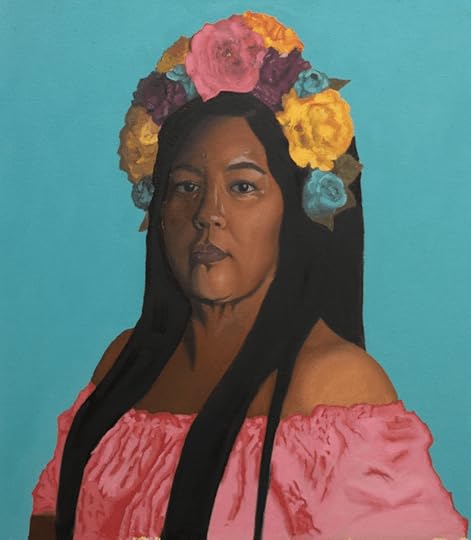
Empoderada: Empowered Brown Skinned Woman, Oil
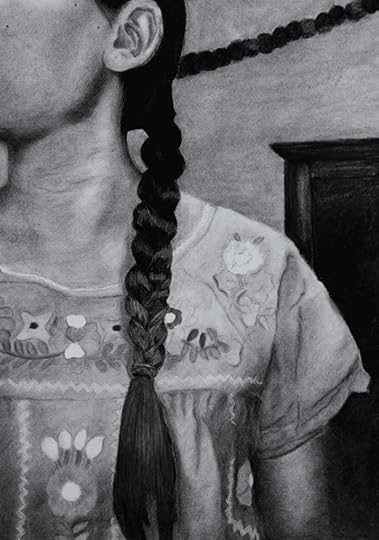
Braided Beauty, Charcoal
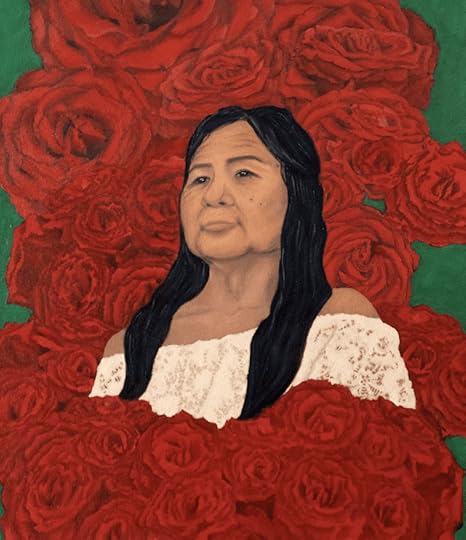
Morena Guerrera
Elisha Fernandez
“The Exponent II BIPOC Artist Scholarship would help me access resources, materials, and support for my multi-disciplinary art projects, including digital art, painting, and writing for my debut novel. The project I would put the majority of the scholarship toward is my debut adult novel. It falls in two main genres: dark fantasy and psychological horror, taking some inspiration from Gothic Victorian aesthetics.
The novel takes place in an uncolonized setting of the Dominican Republic (the island of Quizquéia in Taíno), featuring the indigenous Taíno people. For the fantasy aspect, I’m pulling my inspiration from Taíno mythology. While there are some records of the rituals and culture surrounding Taíno religion, I am mostly creating my own version inspired by my Dominican upbringing and heritage. I am also featuring the now-extinct Taíno language in the book, particularly the variant native to the DR, which I am learning and reconstructing through independent linguistic research.”
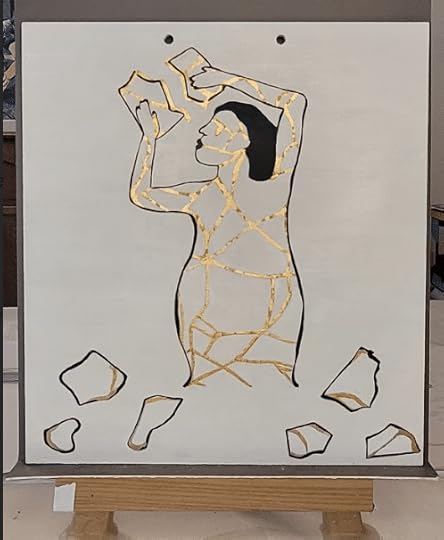
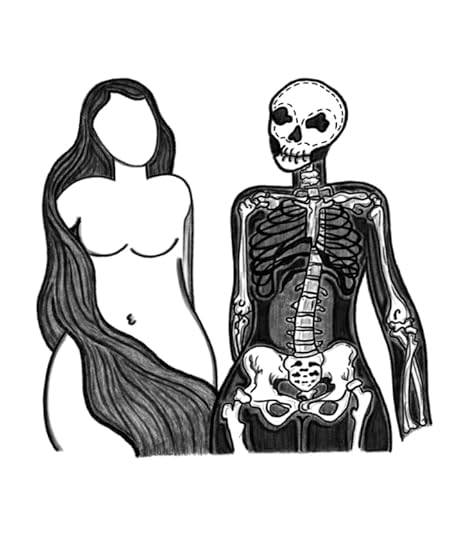

Erica Diane Monson
“I am starting my Master of Fine Arts this Fall at the School of the Museum of Fine Arts at Tufts in Boston.
My work draws specifically from the value my body had in the religious institution I grew up entrenched in, though this experience is one many women face in varying religious and cultural backgrounds. I plan to continue to explore this theme in my MFA. I will be creating mixed media objects and vessels that explore the bodily worth of female bodies through the act of being able to conceive. Because the visual imagery of my work is closely tied to organic motifs, I am interested in utilizing ceramic sprigging and slip casting to construct the wombs from plant and fruit-like forms. Additionally, I am also interested in researching glaze formulations that contain plant and wood ash. While I am primarily interested in working with ceramic materials, I want to experiment with blending the rigid structures of ceramics with softer materials, such as plant matter and textiles.”
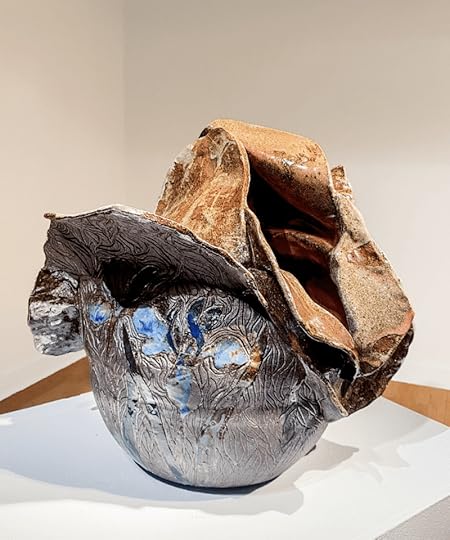
Mother’s Flower, Ceramic Stoneware, 2022
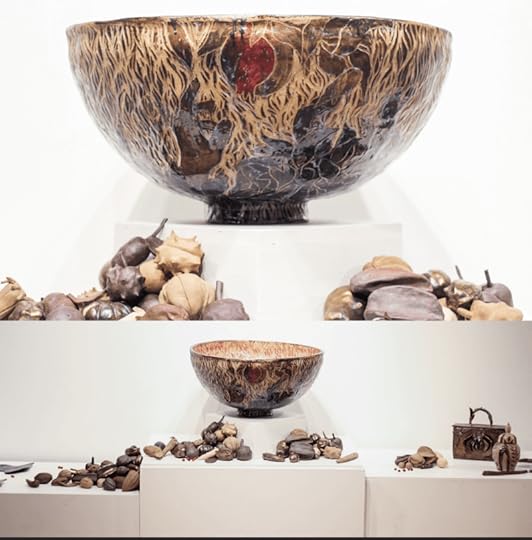
Communion Bowl at the Altar
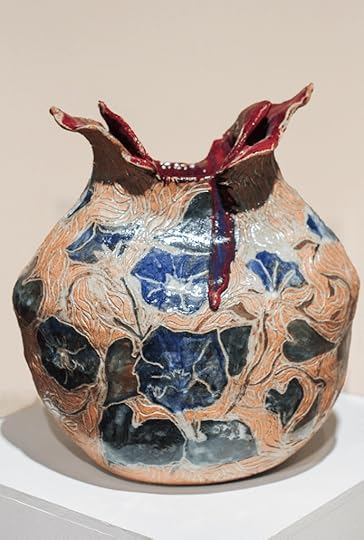
No My Mother Conceived
Amuri Morris
“This microgrant will help my endeavors because I am desperately in need of replenishing my art supplies. I use oil paint, which can be a very expensive medium so this grant will allow me to continue working. I also am interested in expanding to traditional printmaking mediums so this grant would allow me the freedom to expand my artistic practice. In addition to expanding my mediums privately, I also would like to take a professional class. The class I am interested in is a screen printing class at a local arts organization. In addition to learning from experts, I believe that taking this class will help embed me into the local art scene and community. I believe the collective synergy from being around other creatives will fuel my inspired practice. There is a heavy financial strain associated with being a practicing artist and this would allow me to alleviate some of that pressure and help me focus on my work.”

Girl with a Pearl Hoop

Eternal Embrace

Where Red and Green Lines Meet
Many thanks to Rocio Cisneros, our Art Editor, for reviewing and judging the applications.
Donate to these community funds (specify BIPOC Artist Scholarship) to help fund the next round of scholarships.
We welcome art submissions and follow us at @exponentii_mag
Stop Punishing Women When Men Think About Sex
A popular dance aerobics class was recently cancelled at the Provo Recreation Center called “Dirtylicious Dance Fitness”. Despite being popular and well attended for years, an anonymous “gentleman” recently complained that it was inappropriate and classes have now been indefinitely cancelled. From what I can gather, it’s a fun inclusive dance class that includes moves jokingly referred to as “dirty” (like twerking, shaking your body, “drop it like it’s hot”, and shimmying), and is primarily attended by women who get together to dance to fun music and laugh. The creator is a BYU graduate whose goal was to help women gain self confidence while improving their mental and physical well-being in a non-judgmental environment. I think she had that effect, as a class participant shared her devastation with the Daily Herald after she found out it was cancelled:
“I felt as if my lifeline was being taken away with me. This class was the only thing that I did just for me. As a mother of two young boys, I am often taking care of their needs and wants before mine, taking care of the house, taking care of my husband, etc… I needed this outlet to find myself again outside of being a mom or a wife.”
I’ve had classes like that at the gym too, especially during my own years of young motherhood when my military husband was deployed for 12 to 18 months at a time. Days would pass where my only interaction with other adults came from group workout classes at my city’s recreation center, which is only 20 minutes from the Provo Recreation Center. A few days ago in a class I heard more of the background story to Dirtylicious Dance getting cancelled in Provo. The founder bent over backwards to try to find out what was wrong with the class (could she take out a specific dance move?, remove certain songs?, did an instructor say something offensive?), but received no answers. Someone had anonymously complained, the city council voted, and the city cancelled the class with no explanation or opportunity for her to adjust the class to meet their new guidelines.
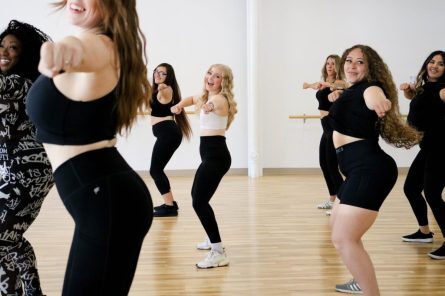 Daily Herald
Daily Herald
Someone at my gym that day spoke up in support of the cancellation and explained that there are two aerobics rooms at the Provo Recreation Center, and suggested that perhaps this class was taught in the one with big glass windows where people could see in. If some of the moves looked sexual in nature, she could understand why it had to be cancelled.
But the women in these classes were primarily moms – and *whispers*…we know that women who have babies have also had sex, right? It felt very infantilizing to hear the women talked about like children who needed to be told that their dance moves were inappropriate. (Or as Youtube commenter Big Goat1440 said, “The problem is it shouldn’t be happening. No one should see a woman doing this or showing this much skin except her husband.”)
The more I think about this situation, the more it makes sense that this happened in the densely LDS city of Provo.
Recently on our blog Instagram, I wrote about the 2013 talk by Tad Callister (President of the Seventy at the time) titled, “The Lord’s Standard of Morality”. Among other troubling remarks, he calls out women for not dressing modestly enough.
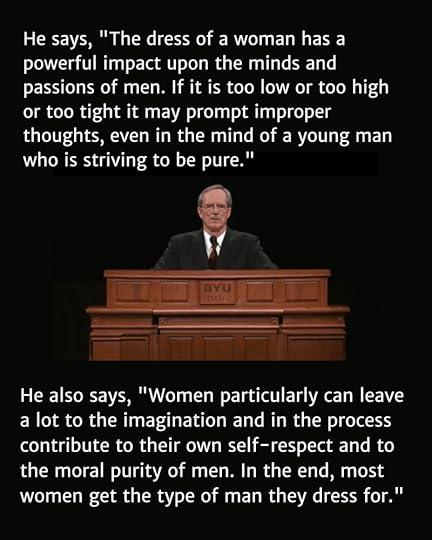
As an LDS girl, young woman and now an adult woman, I have constantly been told (by men) that female bodies are too sexual by nature and we need to cover up. If we wanted to have exercise classes at the local stake center, tank tops were banned. Because there were men at Girl’s Camp, tankinis were banned. We are always the culprit for men’s impure thoughts and responsible for what they are thinking about.
To quote myself from our Instagram account, I have some questions:
When can women start blaming men for being too attractive to us?
When will the general relief society president stand in front of the general priesthood meeting and tell the men to stop swimming without their shirts on?
When will the general young women’s president speak at a BYU devotional and call men in grey sweatpants “tentacles of the evil one” for entrapping women, as Elder Callister described immodest girls in his talk?
When will a female seminary teacher hold boys after class to warn them not to wear their mid calf shorts to class again because it distracts her while she’s teaching?
When will the ward relief society president speak to the young men’s classes and tell them the adult women in the ward will automatically picture them naked if they wear tight clothing?
And now that all sexually arousing dance classes (at least for the men peering into the windows of the aerobics room) have been banned – when will men’s football games be banned? Those pants are way too tight and leave nothing to the imagination. The dress of a man has a powerful impact on the minds and passions of women, often prompting impure thoughts – even in the mind of a young woman who is striving to be pure.
 BYU Football Uniform
BYU Football Uniform
Help Us Keep the Blog Running! Our blog struggles to tackle many tech issues and could use your support! Click here to make a tax deductible donation. Thank you!
July 19, 2025
“Aging” – Call for Magazine Submissions
Consider submitting to the Winter 2025 issue of the Exponent II Magazine.
The theme is “Aging”:
The Japanese philosophy of Wabi-Sabi values transformation in all things — recognizing the beauty of a cracked vase, moss growth on a building, rust-colored metal, and the many ways bodies change in time. Our scriptural canon also frequently emphasizes the passing of time (“And it came to pass . . .”). In this winter contest issue, we want to read about the kaleidoscope of aging, about the effect time has on each of us, its emotions and transformations.
How has aging changed your relationship with yourself? Tell us about those moments when you realize time has passed, when you find yourself changed, grown, aged, re-revealed to yourself. Or, if you could write to yourself at a specific time, what would you say to that other version of yourself? What might they tell you? How does aging impact our cultural and personal beliefs? How might aging change the way we see our bodies as holy sites (or the ways in which we don’t)? How does aging evolve our view of perfection?
The first-place poetry and prose winners will each receive $100. The first-place artist will receive a four-page feature in an upcoming issue.
We welcome all fiction, essays, poetry, and art that engages with aging. Please email written submissions to editor@exponentii.org by Oct 15, 2025 (see full guidelines). Authors and artists should identify with the mission of Exponent II.



